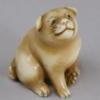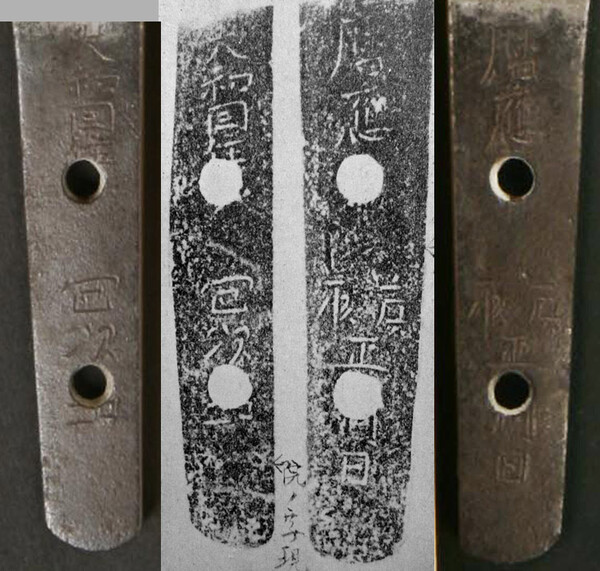-
Posts
341 -
Joined
-
Last visited
-
Days Won
2
Content Type
Profiles
Forums
Events
Store
Downloads
Gallery
Everything posted by leo
-
Sorry Chris, missed your question. "Contemporary" in this case means forgeries that were made, when the genuine smith was still working. As I have read, this is particularly the case with Kozuke Daijo Sukesada. Apparently his works were so much in fashion and high-priced, that there were many more forgeries done during his active years than later on. Best, Martin
- 14 replies
-
- translation
- wakizashi
-
(and 1 more)
Tagged with:
-
Hi Chris, this smith and his signatures has been discussed here plenty times. You should find good information and pictures here and hundreds on google. What I can say though is that that the signature in many aspects does not match the "famous" Shinto Kozuke Daijo. There is neither Fujiwara nor Osafune in the mei, the mei is just on one side and the general style especially the Sada kanji does not match. But as others have said before, this was a smith who was faked by a lot of contemporary forgers. Now there is a later smith mentioned in Hawley who worked around 1750. If he exists at all(I could find no confirmed reference mei), he might be a match for your blade. Grey, you probably meant 1680, not 1860. Best, Martin
- 14 replies
-
- translation
- wakizashi
-
(and 1 more)
Tagged with:
-
Think, you are right, Ian, these were made by Chinese craftsmen and imported into Japan either complete or as segments. Also the aoi mon on the brass fittings are typical and should make them look official. Interesting that the "Chinese Fake" has such a long tradition! The blades were made from iron sheet without exception. There is another type of high end ivory koshirae made by netsuke or okimono carvers during the 19th and 20th century also for export. Usually these were made out of segments from one tusk containing a simple iron blade with an extreme sori. These are no nihonto either, but pieces of art and should not be confused with the cheap bone swords. The top of the line were the shibayama style ivory koshirae with intricate inlays of multicolored pieces of mother of pearl, red coral and such. Best, Martin
-
Brian, maybe you are right. No use to compare prices without holding the blade in hand. Besides the very different taxation in the various countries make a big diference(Germany 19%). Jean, this actually means the price of the sword in question contains about 5.000,-€ VAT, which can be refunded for export, apart from additional discount by the proprietor . For German collectors and dealers I would like to add one interesting thing: I mentioned 2% Customs fee. Now I am well aware that there is no customs fee on antiques. Still, my invoices explicitly do not bear the remark "Antiques". The reason is the handling procedure of German customs. If they see "Antiques" on the attached invoice of an expensive item, they automatically suspect that somebody is trying to cheat. Now the merchandise resides for quite a while in the crude hands of sometimes very ignorant people, who try to find out if this is really an antique item. Sometimes, on my expense, an "expert" of the Frankfurt Chamber of Commerce has to certify its age. All this might take weeks and if you ever received a TH blade with etched in fingerprints or a JT blade with a broken tip, you rather pay the "penalty tax" and the merchandise is directly delivered to your hometown customs office without delay and damage. It is sad, but a summary of 40 years of import experience! Chris, by the way, this lecture about sword length valuation was very interesting, thank you. Best, Martin
-
Jean, if you compare apples to pears you may be right. The Aoi-Shikkake-blade is not only shorter, but also has plenty of faults. Even the nice mounts cannot compensate this. If you in addition consider the VAT and tax, the prices are not that far apart. Best, Martin
-
I do not see a single feature which would make it Japanese. Best, Martin
-
Same name as a famous ukiyo-e artist. Best, Martin
-
Oh! that was silly! Did not know it was the new default avatar. Wondered already why so many had the same taste!
-

Refinish And Polish, Or Not
leo replied to Richard Waddell's topic in General Nihonto Related Discussion
Richard, this is correct, the nakago would become longer. In some cases this was adjusted by cutting the tip(jiri) accordingly. Then it is a suriage nakago. As in this case the machiokuri is minimal, you still might have the original jiri. For the rather small shortening there could have been several reasons. Usually it was damaged hamachi, a flaw, a battle scar or the wielder simply wanted it half an inch shorter. I doubt that it was shortened for the gunto tsuba, but anything is possible. Best, Martin -
Ray, the engraved mon is well executed, so there is hope. Poorly executed mon are usually a sure sign of one of the many Yasutsugu fakes. Raymond, James , can it be that you use the sam icon? A bit confusing. Best, Martin
-

Refinish And Polish, Or Not
leo replied to Richard Waddell's topic in General Nihonto Related Discussion
Sorry, off course the ana moved down if the hamachi moved up! -

Refinish And Polish, Or Not
leo replied to Richard Waddell's topic in General Nihonto Related Discussion
Hi, Richard, the hamachi has been moved up(machiokuri), therefore it is so crisp and the the ana has moved up, too. The nakago is not ubu then. Apart from that the nakago and signature looks good to me. As for the blade, like the others already said, it is difficult to tell whether this patient can be reanimated. If you seriously want to try to restore this blade with all the costs involved, I would start to polish a small window on the boshi near the tip. This seems to be the part which was abused most. Best, Martin -
DHL ships almost everything. The issue is insurance. this varies due to the country you send to or from. For many countries insurance amount is limited to 500€. Same goes for unique antiques, jewelry etc., they are not covered. Here I would recommend a separate transport insurance issurd by many insurance companies. They cost around 1% of the insured value. This is recommended also to such buyers whose transport documents show that they paid very little money for their goods. This goes for EMS, too. EMS delivers without problems to Frankfurt-Airport/Germany, which is in the center of Europe. If you google the shippers(like Schenker) located there, they can handle import plus surface shipping to neighbouring countries. There are additional costs involved, but still better than no shipping! Best, Martin
-
While the other two are of more traditional shape, this one is really funny! It has a hairy apelike body, bangles on hands and feet, a shishi head and a kind of saddle. Maybe something from an early carnival or freak show? :beer: Martin
-
Jason, if I am not mistaken, this has been painted with the type of gold paint which is used for restoration purposes. It is made with real gold powder to prevent it from darkening. As far as I remember this lacquer is pretty expensive, but the gold application is so thin that the value is not worth mentioning. Basically it is the same paint and method as the aluminium paint used for stove pipes, exept that real gold is used. It is a rather modern paint and has nothing to do with the matte or shiny urushi gold-lacquer which was used to paint metal fittings. If genuine gold parts are involved somebody surely invested a lot to restore these fittings to his individual taste. Best, Martin
-
Sorry, Steve, I think Chris is right(like so often) The nakago looks artificially corroded, probably to match the Ichimonji-look of the blade. Looks like gendai to me, too. Best, Martin
-
Hi, even though the pictures are blurred it it obvious that it is an orikaeshi mei. Which Kanemoto it is supposed to be?(I guess the seller made some suggestion) 2nd Magoroku is 3rd Kanemoto, 1st Magoroku is 2nd Kanemoto. It looks a bit stamped because the chisel strokes are obscured by age which can happen. The hamon seems to be regular and irregular gunome which can be a Mino school feature. The tips of the gunome are round though, not pointed and there is not even a hint of sanbonsugi. All this is not too typical for Kanemoto. There are always exceptions, though. Orikaeshi mei with a great name are no guarantee of authenticity. There have been fakes as many people think a faker would not bother with the additional effort. More often, though, original gaku mei are inserted into other blades which seems not the case here. Nobody here will confirm the genuineness of a signature. As Brian said, this is up to a shinsa team. What can be done is to give an opinion or a recommendation. Best, Martin
-

Rare tanto published in 1935 was discovered in my collection
leo replied to Christian Chaffee's topic in Nihonto
Interesting reference piece, Darcy! This sort of mei is called kakikudashi-mei (書下し銘) and there is a very interesting article by Markus referring to this: https://markussesko.wordpress.com/2014/08/ Apparently this mei was used during Kamakura and Nanbokuchyo era, in Yamato province mostly on tanto and with the name coming after the date. Best, Martin -
Nice looking hamon. Shortened Katana or Tachi. The 2nd ana may be the original. I do not see a yokote, but after the polish it should have a nice o-kissaki. I hope, the tip can be saved. I cannot really tell from the pictures how old this blade is and exactly what school. But, as the shortening looks already old to me, a logical conclusion would be that it is a Koto blade. Regards, Martin
-

Rare tanto published in 1935 was discovered in my collection
leo replied to Christian Chaffee's topic in Nihonto
Now I found the term: The "photomontage" was unprofessional! Martin -

Rare tanto published in 1935 was discovered in my collection
leo replied to Christian Chaffee's topic in Nihonto
Jean, maybe a misunderstanding. I meant the graphic equipment of the layout people/printers who obviously tried to match 2 warped and missized photos of the oshigata. No macs and no photoshop in 1929 :lol: Best Martin -

Rare tanto published in 1935 was discovered in my collection
leo replied to Christian Chaffee's topic in Nihonto
Definitely the same blade. Due to the technique of that time the 2 oshigata images do not have the same size and proportion. The left image is warped, too. Then oshigata always look mor 2-dimensional than a photo, the ana look larger etc. I adapted the photos to the different sizes of the oshigata which should make it clear to everybody. Best, Martin -
Hi, I can only confirm the previous posts: blade shoud be polished and submitted to shinsa. It looks like a shinshinto remake of a Koto- Bizen Nanbokucho- period sword, like Omiya-school. Restoration of this koshirae will require some effort. I would stick with a shirasaya, but this is a personal decision. Best, Martin
-

Rare tanto published in 1935 was discovered in my collection
leo replied to Christian Chaffee's topic in Nihonto
Probably Kanetsugu or his son Kanesada. I checked on this book "Token Jissho Kantei Ho". Koshoyama offers an edition from 1929. Martin




